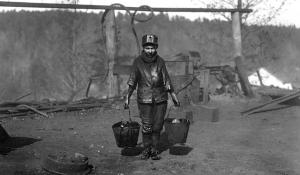
What’s really going into the chocolate we buy? The Chocolate Scorecard surveyed the world’s biggest chocolate companies to find out!
Some are rising to the challenge of making cocoa sustainable, unfortunately most continue to ignore consumer demand for chocolate that’s free of deforestation, farmer poverty, and child labor.
This guide informs the choices of consumers like you. Together, we can transform the chocolate industry into one that prioritizes people and the planet.
Sign our petition asking the world's largest chocolate companies to address child labor, farmer poverty, deforestation, and pesticide usage.
Chocolate Scorecard Methodology
The Chocolate Scorecard uses the Brundtland Commission's definition of sustainability:
"meeting the needs of the present without compromising the ability of future generations to meet their own needs."
Additional components of the methodology in 2023 included:
- Using subject matter experts to undertake the scoring in each section;
- Aligning the survey with the Science Based Target Initiative (SBTi),
- The Carbon Disclosure Project (CDP) and
- The Accountability Framework (AFi).
The survey covered six categories:
- Traceability and Transparency
- Living Income
- Child Labor
- Deforestation and Climate
- Agroforestry
- Agrichemical Management
An explanation of the categories:
Traceability and transparency
According to the United Nations Guiding Principles on Business and Human Rights, a business is responsible for any and all adverse human rights impacts either through their own activities or due to their business relationships with other parties. It is not appropriate to ‘outsource’ this responsibility or to shift the responsibility to the next or another tier in the supply chain.
A company that lacks knowledge of its cocoa’s origin (an issue of traceability) cannot genuinely ensure it is not tainted by extreme poverty, child labor, deforestation, or other abuses. Without transparency on this traceability, civil society cannot hold companies accountable. Transparent traceability is a crucial bedrock for all other reforms.
Traceability and transparency constitute 20% of the total overall score.
Living Income
A living income is:
The net annual income required for a household in a particular place to afford a decent standard of living for all members of that household. Elements of a decent standard of living include food, water, housing, education, healthcare, transportation, clothing, and other essential needs including provisions for unexpected events.
This is not a reality for cocoa farmers and their families in West Africa. Many live in extreme poverty, making them more vulnerable to hunger, malnutrition, health crises, and other social challenges, including exposure to child labor.
The highest scores were achieved by companies that are:
- using an actual living income calculation to benchmark their programs; and/or
- making payments to farmers on top of Living Income Differential (LID) set by the Governments of Ghana and Côte d'Ivoire and certification premiums; and/or
- investing in development projects determined in consultation with the communities they are sourcing from.
The Living Income category contributed 20% to the total overall score.
Child Labor
Despite voluntary corporate efforts promising to eradicate it, the prevalence of child labor has increased by 14% over the past decade.
- 1.56 million children exposed to child labor in cocoa production (including approximately 790,000 children in Côte d’Ivoire and 770,000 in Ghana)
- 1.48 million children were exposed to at least one component of hazardous child labor in cocoa production; and
- Between 2008/09 and 2018/19, children exposed to agrichemical products increasing approximately five-fold from 5% to 24% in aggregate
Poverty and extremely low incomes are linked to children's exposure to child labor and hazardous child labor, depriving them of their future and subjecting them to abuse.
The Chocolate Score analyzed responses in three areas for this category:
- Any child labor policy, monitoring and remediation system or equivalent (Child Labor Monitoring and Remediation Systems - CLMRS);
- Percentage of farms covered by the scheme; and
- Presence of a plan to scale up programs and processes to address child labor.
The Child Labor category contributed to 20% of the total overall score.
Deforestation and climate
Cocoa is a major global driver of forest destruction. West Africa produces 75% of the world’s cocoa, with Côte d’Ivoire and Ghana being the largest producers. These two countries have lost most of their forest cover in the past sixty years - around 94% and 80%, respectively, with approximately one-third of forest loss from cocoa growing.
Almost everywhere cocoa grows worldwide, from Asia to Africa to Latin America, studies show it is tied to deforestation, which negatively impacts climate change. As such, this section also focuses on the industry’s contribution to global annual greenhouse gas (GHG) emissions leading to severe climate change.
The chocolate scorecard analyzed the responses in the following areas for this category:
- Application of no-deforestation policy to global sourcing and percentage of cocoa purchased through a deforestation-free monitoring system;
- Percentage of cocoa sourced from deforested areas since various cut-off dates;
- Detailed plans for how to respond to evidence of suppliers sourcing cocoa from recently deforested land; and
- Policy to achieve net zero carbon emissions company-wide or using science-based targets.
Deforestation and climate change actions contributed 20% of the total overall score.
Agroforestry
Though cocoa has been a major driver of deforestation worldwide, it can become the reverse - an agent of re-greening around the planet. Agroforestry, as opposed to pesticide-soaked monoculture, is a more ecologically sound way of growing cocoa and restoring farming landscapes.
Scientific research demonstrates that robust agroforestry cocoa systems are better for the planet, carbon sequestration, soil and air moisture retention, and biodiversity. Studies show it is also better for farmers’ food security and income diversification.
The Chocolate Scorecard analyzed the responses in four areas for this category:
- Any agroforestry policy and its definition;
- Application of the agroforestry policy, either globally or to West Africa only;
- Assessment and monitoring of the agroforestry policy;
- Support and investment in farmers within the supply chain to transition to agroforestry growing methods
Agroforestry contributed 10% to the total overall score.
Agrichemical Management
As we face a mass extinction crisis, much of which is driven by chemicals in agriculture, chocolate companies need to reform their current approaches and adopt practices that do rely on agrichemicals.
Increased productivity via chemical inputs cannot be the primary means for companies sourcing increasing amounts of cocoa. Instead, the long-term sustainability of the industry, the health of the farming communities (who often rely on neighboring rivers for drinking and bathing), soil health, and the planet's health must become a priority.
To achieve this, companies must eliminate the most hazardous pesticides entirely and move towards reducing the overall use of agrichemicals. They should support farmers in transitioning to agricultural practices that do not rely on dangerous chemicals while helping them maintain their yield and income.
Companies should emphasize non-chemical interventions such as grafting, pruning, hand pollination, and education around best agroecological practices and Integrated Pest Management (IPM) to increase yields for farmers.
The Chocolate Scorecard analyzed the responses in three areas for this category:
- Any stated targets and policy to reduce pesticides;
- Assessment and monitoring of hazardous pesticides in the supply chain and action to phase the use of hazardous pesticides out;
- Support for the adoption of non-chemical alternatives.
Pesticides contributed 10% to the total overall score.






